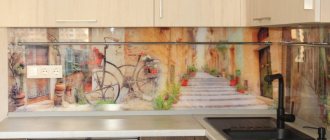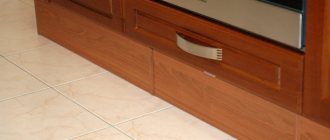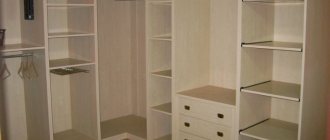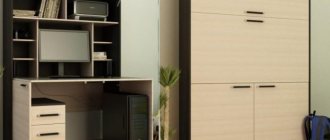The modern layout of the apartments allows the owners to have a large area, a spacious bathroom, living room, and dressing room. But this does not apply to Khrushchev buildings, in which, due to the small area, they tried to use every square meter with maximum benefit. Architects of the sixties squeezed the most out of even a small kitchen, so they equipped the space under the window as a refrigerator. In those years, not every family could boast of household appliances, so such a solution was simply necessary. In some apartments, the niche under the window in the kitchen is empty, leaving space for a heating radiator.
Kitchen design with a niche under the window.
The peculiarity of the niche is that part of the brickwork in this area is missing. In the case of an installed refrigerator, almost the entire thickness of the brickwork is missing, with the exception of 1 layer. Due to this and the presence of a ventilation hole, it maintains a low temperature. Like the housing itself, the winter refrigerator looked simple and unpretentious: rough folding doors and a shelf painted blue. Modern owners, even if they leave the recess as a cold cabinet, try to improve its appearance.
Kitchen design in Khrushchev with a niche under the window.
Niche under the kitchen window: ideas and implementation
In almost all cases, the niche under the window in the kitchen is intended for installing a heating radiator. This arrangement of the heating device is the most natural, because during operation it not only heats the room with thermal radiation, but also creates a thermal curtain, cutting off the cold air coming from the window. At the same time, with some layout options, the niche in the wall under the window remains free and is used for other purposes. A niche in the kitchen under the window is a good solution for storing food.
- Khrushchev's “refrigerator” in the kitchen
- Options for using a niche under the window: how to arrange a practical place Niche-cabinet
- Niche “refrigerator” in the design of the refectory
- Sink installation
- Installing a radiator: is it necessary to insulate the room?
Kitchen with sink by the window
A kitchen with a sink under the window is now perhaps the most fashionable design solution. This option assumes that the dishes can be washed while periodically enjoying the views from the window, or watching children play on the playground in front of the house.
Washing by the window can save some energy, since lighting the work area will provide natural daylight.
History of Khrushchev's refrigerators
The idea of building a niche under a window arose in the last century. The reason for this was the shortage of household appliances. Not every family could afford to buy a refrigerator. In addition, the models produced at that time were quite large and did not fit the size of small Khrushchev kitchens at all.
Design engineers found a way out of this situation. The option of a refrigerator built under the window was an excellent economical solution.
A fairly spacious niche did not take up space in the kitchen. We used it to store food in the winter. A thin brick wall inside the cabinet made it possible to fill the space with cold when the air temperature outside was low. Thanks to two tightly closing doors on the kitchen side, the required mode was maintained in the compartment.
Nowadays, such niches are often called Khrushchev refrigerators. For housewives of small-sized kitchens, a spacious cabinet under the window is just a godsend. You can store canned food and other non-perishable products in it. At the same time, the refrigerator compartment does not take up any space in the kitchen.
Door trim
The appearance of the refrigerator directly depends on the doors that will be used. If you decide to leave everything as is, it will be enough to refine and insulate the old doors a little. In other cases, you will have to order the design most suitable for the kitchen interior or try to do something yourself.
Insulation and decoration of old doors
It’s worth clarifying right away that when using old doors, a significant energy-saving effect is unlikely to be achieved. To ensure the preservation of coolness inside the cabinet, it is necessary to seal the doors as tightly as possible, and this is only possible with perfectly smooth surfaces and the presence of a seal.
You can glue a rubber seal, but it will most likely not be possible to straighten crooked wooden doors. Of course, the seal partially compensates for unevenness, but doors of this design do not have fittings that would ensure tight pressure. Therefore, you will have to make something locally, depending on specific technical conditions.
An inexpensive and accessible option is to insulate the doors on the side of the refrigerator with foil insulation and glue a sealing rubber band where the doors join the frame. As an external decor, you can use self-adhesive film of a suitable color.
Metal-plastic construction
Installing a metal-plastic block is a simple and effective way to seal your refrigerator and keep your kitchen warm. This is especially convenient if your home is undergoing a planned replacement of windows, since most manufacturers provide a discount on their products for large orders. However, the surveyor should be called only after the final completion of the opening.
Plastic profile with frosted glass looks more interesting
When ordering, you should not choose an expensive multi-chamber profile, since the window will not be subject to temperature changes and other atmospheric influences. A sandwich panel installed instead of a double-glazed window will help you save a little and hide the contents of the refrigerator.
The finished frame is waiting in the wings
Thanks to the variety of colors and textures of PVC profiles, choosing a design that best suits the kitchen interior is not difficult.
An interesting option with mirrors instead of glass
Installation of furniture doors (chipboard, MDF)
To ensure that the external design of the refrigerator cabinet does not stand out against the background of the kitchen unit, the optimal solution would be to make them with exactly the same finish. The ideal option is to order the doors along with the kitchen set.
More light!
Another interesting option has begun to gain popularity, when all the brickwork from a niche is removed and a double-glazed window is installed in its place.
This option is relevant for apartments whose kitchens face north and require an additional light source.
In this case, the double-glazed window can be small, repeating the dimensions of the niche, or have the shape of a circle (semicircle).
A large double-glazed window will add beauty to the kitchen interior if the kitchen window is “extended” to the floor by removing the brickwork.
This kind of work cannot be done with your own hands and you will have to invite professionals for repairs - finishing craftsmen and window installation specialists.
Some housewives will find a double-glazed window, like for a balcony door, inconvenient, because it will deprive them of the window sill area. However, the problem is easily solved by installing the same countertop as the kitchen unit.
When renovating a kitchen, many questions arise. For example, what materials are best for flooring?
Which of the five ceiling options to choose for the kitchen? Read in this article.
What is decorative plaster and how to use it in the kitchen? The answer is here.
In conclusion, we can say that a small kitchen in a Khrushchev building is not a death sentence.
It is enough to change your outlook to a more positive one, think through and rationally use every centimeter, and a creative solution will definitely appear.
We invite you to watch a video about repairing a winter refrigerator.
Photos of interesting options for building cabinets and cabinets under the kitchen window sill
Strictly speaking, in order to make a cabinet under the window sill in the kitchen with your own hands, it is not at all necessary to have a niche for a Khrushchev refrigerator. Many design projects involve the continuation of the kitchen unit along the wall with a window. In this case, cabinets with shelves are built under the window sill, taking into account the location of the radiator and heating riser.
It’s just that a niche provides more opportunities in terms of solutions. There are photos showing a washing machine built into a niche.
Or a refrigerator and freezer. Quite effective ergonomics for small-sized Khrushchev-era kitchens.
However, it is more interesting, of course, to look at the drawings and photos of how the cabinets themselves are built under the window sill. And then it turns out that there is nothing complicated. In their design, they are quite consistent with the standard modules of the lower row. Only made to individual sizes.
The main thing is to correctly measure and calculate all the parts for further assembly. Let's look at how to make a cabinet under the window sill in the kitchen using a specific example.
What to do with heating radiators
They can easily be hidden under special panels. Ventilation holes should be made in them. It is recommended to move the batteries to an adjacent wall if the kitchen design requires it and there is such an opportunity.
There is another idea: to abandon the need to use general heating systems in the kitchen and install heated floors.
Use the niche for storing vegetables and canning
To avoid loading the refrigerator with vegetables in the winter, you can use this niche as a cold pantry. If necessary, insulate the wall a little so that during severe frosts the vegetables do not freeze. Replace shelves and front doors with more modern and practical ones. You can even use glass ones, the only condition is that there must be order so as not to spoil the aesthetic appearance of the interior.
Store things and objects in a niche
Depending on how you organize the space around this niche, you can store both very popular things and objects there, and vice versa. If there is free access to it, then place those items that you use constantly. If access is limited, it is very convenient to put there everything that you use rarely or seasonally. But in any case, such an additional cabinet can free up a table or hanging shelves for you. In this case, it is advisable to insulate the wall so that cold air does not penetrate into the apartment. Such a niche can be made with both open and closed shelves.
Install the battery in the niche
This niche can be used as a place for a radiator, having previously insulated the wall with heat-insulating materials. If you place it in the depths of the free space, you can not only solve the problem of heating the apartment, but also significantly save space.
Design Features
The “Khrushchev refrigerator” is a deep niche located under the window in the kitchen, in place of a traditional heating radiator (in these projects the radiators are slightly shifted to the side). In this place, the street is separated from the room by a small layer of brickwork, which contains technological gaps for the penetration and circulation of cold air, as well as for ventilation.
The modest dimensions of the niche in those days were quite enough for the periodic storage of perishable products for six months. In addition, the window-sill refrigerator made it possible to save kitchen space , depriving the owners of the need to purchase alternative electrical equipment.
The kitchen window sill replaced the table in the warm season, and the space under it was used as an additional area for storing non-perishable foods.
Advantages of the design:
- additional space;
- saving energy on using a refrigeration unit in winter;
- the presence of a mini-pantry for preservation during warm periods.
And most importantly, there is always the opportunity to remake the refrigerator using a niche at your discretion.
Material selection
When choosing raw materials for arranging the area near the window sill, you need to focus not only on its attractive appearance, but also on the quality of workmanship. For the kitchen it is best to choose the following materials:
- Natural wood. Hardwood structures are ideal. They are not affected by moisture and last longer with constant contact with piercing and cutting cutlery. But in order for this material to remain attractive for a long time, it is opened with varnish.
- MDF. These are raw materials made from wood and plastic particles. Ideal for kitchen worktops. If used improperly, it quickly deteriorates. Over time, it loses its protective layer due to abrasions, vibrations and shocks.
- Chipboard. The material is slabs made from reliably compressed lumber. It is natural, despite the presence of plastic elements. Does not emit any unpleasant odor or toxins.
- Plastic. This is a fragile material. Therefore, it is ideal for arranging a decorative tabletop. Light accessories and thematic paraphernalia are placed on such surfaces. It is prohibited to place pots of flowers and dishes on a plastic tabletop.
- Acrylic. An artificial stone that has proven itself well. It is considered budget-friendly and has a wide range of colors. It is lightweight and performs well even with prolonged exposure to moisture and sunlight.
- Granite or marble. These are natural stones that have an attractive appearance. Such raw materials are very expensive, but last for several decades. Not subject to mechanical influence.
On a note! Materials made from wood species lend themselves well to restoration, unlike plastic, MDF or laminated chipboard coatings.
Modern Use Options
Now the niche is being adapted for completely different things.
- A cabinet with drawers or shelves - open or hidden behind hinged doors. In one or the other case, they can be used to store either pickles or kitchen utensils. It all depends on the need.
- Place for a heating radiator. If the house is cold and additional space for storing food is not required, the niche is just right for another battery.
- Electric fireplace. This is a sleeker alternative to a radiator that can completely transform the look of a small kitchen.
- Safe. Some people use the niche under the window left over from the Soviet past in exactly this way. You can make a fireproof box that is inaccessible to strangers by providing it with a secure lock. And if it is properly disguised, then it is unlikely that anyone will even suspect that there is a hiding place in the kitchen.
- Built-in dishwasher or washing machine. Small models of household appliances will fit well into the kitchen space if you manage the former refrigerator wisely.
- Place for a hob or sink. This option, like the previous one, cannot be called easily implemented, but the niche becomes an integral part of the kitchen workspace.
- Space for a dining area. If you remove the niche under the window and install a tabletop instead of a window sill, sitting next to it becomes very comfortable - your feet don’t rest against the wall. This is a good option for a married couple or a person who lives alone.
The most radical method is to completely remove the niche and make a French window in the kitchen.
However, it must be taken into account that it is impossible to transform such a plan without looking at the special services that issue permits for work of this kind. In addition, the costs in this case are quite serious. They are justified when there is little light in the kitchen.
Disadvantages of a table top-window sill
A window sill table that is installed in the kitchen has several significant disadvantages. If they are not taken into account in a timely manner, then the equipped place will not bring any benefit:
- Self-installation is not for everyone. This requires knowledge in the field of construction.
- There is a high risk of getting a fake. If you chose a natural stone, but it turned out to be just an imitation.
- Moisture can get into the cracks between the countertop and the glass unit, and this is a breeding ground for fungus and bacteria.
- If the tabletop is damaged, it must be completely replaced; local restoration will not be rational.
- If the level of the window sill and the height of the floor unit do not match, you have to look for ideas on how to get around this problem.
The listed disadvantages are not worth giving up a beautiful design solution for your kitchen. The table top-window sill will emphasize modernity and concentrate attention.
Window sill with built-in sink and continuing countertop Source dizainkyhni.com
Interesting options in the interior
Once a kitchen structure is installed, its design can be varied in all sorts of ways. If you don’t style the refrigerator as a kitchen set (as mentioned above), you can show your author’s imagination. Here, different options are already possible at the discretion of the master: this is pasting plastic doors with wallpaper (as an option, 3D photo wallpaper), and processing the doors along the edges with beautiful patterned strips (plastic or wooden).
Particularly creative individuals may be interested in artistic door painting and many other alternatives. You can choose an acceptable design style to suit the taste of the kitchen owner. This design, again with careful consideration of the issue, can easily and harmoniously fit into any interior of the room, giving it interesting notes.
As a result, we can conclude that with the right approach, a refrigerator under a window in buildings where such a design can be used will be an excellent solution for any kitchen.
To learn how to make a refrigerator under the window with your own hands, see the following video.
Sequence of work
When performing insulation with your own hands, you should adhere to the following sequence:
- Completely free the niche. Remove shelves and mountings for them.
- Clean the surface from old insulation or paint.
- Clean the ventilation hole and install a louvered metal grille on it (with the ability to regulate the flow of outside air).
- Plaster the surface of the walls.
- Prime the dried surface with acrylic primer for walls 2 times (with an interval of 3-4 hours).
- Make a hole in a sheet of penotex cut to size, located opposite the hole in the back wall of the refrigerator. The hole should be cut in a cone shape, with the narrow end facing the street. The resulting cone should be equipped with a loop handle and used to regulate the flow of cold air in severe frosts;
- Using adhesive mastic (“liquid nails”), stick a sheet of penotex 30-40 mm thick onto the back wall of the refrigerator.
- Cover the upper (under the window sill) wall with penotex.
- Glue a sheet of penofol insulation with a thickness of 3-10 mm on top of the penotex. also cover the side walls, ceiling and floor of the refrigerator with penofol (the thickness of the penofol does not play a significant role, its main function is screen).
- Glue all joints between penofol with foil tape.
At this point, the finishing of the interior space of the refrigerator under the window is completed.











